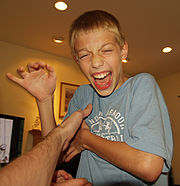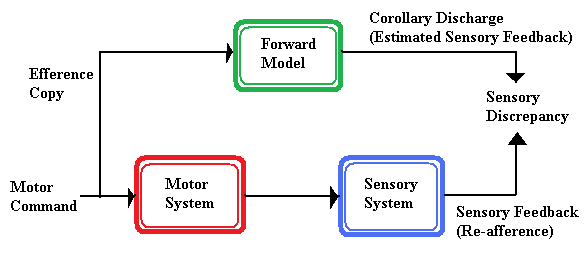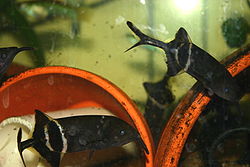
Efference copy
Encyclopedia

Efference copies are important in enabling motor adaptation such as to enhance gaze stability. They have a role in the perception of self and nonself electric fields in electric fish
Electric fish
An electric fish is a fish that can generate electric fields. It is said to be electrogenic; a fish that has the ability to detect electric fields is said to be electroreceptive. Most electrogenic fish are also electroreceptive. Electric fish species can be found both in the sea and in freshwater...
. They also underlie the phenomena of tickling
Tickling
Tickling is the act of touching a part of the body so as to cause involuntary twitching movements and/or laughter. The word evolved from the Middle English tikelen, perhaps frequentative of ticken, to touch lightly. The idiom tickled pink means to be pleased or delighted.In 1897, psychologists G...
.
Motor signals

Central nervous system
The central nervous system is the part of the nervous system that integrates the information that it receives from, and coordinates the activity of, all parts of the bodies of bilaterian animals—that is, all multicellular animals except sponges and radially symmetric animals such as jellyfish...
(CNS) to the periphery is called an efference, and a copy of this signal is called an efference copy. Sensory information coming from sensory receptors in the peripheral nervous system
Peripheral nervous system
The peripheral nervous system consists of the nerves and ganglia outside of the brain and spinal cord. The main function of the PNS is to connect the central nervous system to the limbs and organs. Unlike the CNS, the PNS is not protected by the bone of spine and skull, or by the blood–brain...
to the central nervous system is called afference. On a similar basis, nerves into the nervous system are afferent nerve
Afferent nerve
In the nervous system, afferent neurons , carry nerve impulses from receptors or sense organs towards the central nervous system. This term can also be used to describe relative connections between structures. Afferent neurons communicate with specialized interneurons...
s and ones out are termed efferent nerve
Efferent nerve
In the nervous system, efferent nerves, otherwise known as motor or effector neurons, carry nerve impulses away from the central nervous system to effectors such as muscles or glands...
s.
When an efferent signal is produced and sent to the motor system
Motor system
The motor system is the part of the central nervous system that is involved with movement. It consists of the pyramidal and extrapyramidal system....
, it has been suggested that a copy of the signal, known as an efference copy, is created so that exafference (sensory signals generated from external stimuli in the environment) can be distinguished from reafference (sensory signals resulting from an animal's own actions).
This efference copy by providing the input to a forward internal model
Internal model
An internal model is a postulated neural process that simulates the response of the motor system in order to estimate the outcome of a motor command....
is then used to generate the predicted sensory feedback that estimates the sensory consequences of a motor command. The actual sensory consequences of the motor command are then deployed to compare with the corollary discharge to inform the CNS about how well the expected action matched its actual external action.
Corollary discharge
Corollary discharge is characterized as an afference copy of an action command used to inhibit any response to the self generated sensory signal which would interfere with the execution of the motor task. The inhibitory commands originate at the same time as the motor command and target the sensory pathway that would report any reafference to higher levels of the CNS. This is unique from the efference copy, since the corollary discharge is actually fed into the sensory pathway to cancel out the reafferent signals generated by the movement. Alternatively, corollary discharges briefly alters self-generated sensory responses to reduce self-induced desensitization or help distinguish between self-generated and externally generated sensory information.von Helmholtz
The first person to propose the existence of efferent copies was the German physician and physicist Hermann von Helmholtz in the middle of the 19th century. He argued that the brain needed to create an efference copy for the motor commands that controlled eye muscles so as to aid the brain's determining the location of an object relative to the head. His argument used the experiment in which one gently presses on ones own eye. If this is done, one notices that the visual world seems to have "moved" as a result of this passive movement of the eye ball. In contrast, if the eye ball is actively moved by the eye muscles the world is perceived as still. The reasoning made is that with a passive movement of the eye ball, no efferent copies are made as with active movements that allow sensory changes to be anticipated and controlled for with the result in their absence the world appears to move.Sherrington
In 1900, Charles SherringtonCharles Scott Sherrington
Sir Charles Scott Sherrington, OM, GBE, PRS was an English neurophysiologist, histologist, bacteriologist, and a pathologist, Nobel laureate and president of the Royal Society in the early 1920s...
, the founder of modern ideas about motor control, rejected von Helmholtz ideas and argued that efference copies were not needed as muscles had their own sense of the movements they made.
"The view [of von Helmholtz and his followers] which dispenses with peripheral organs and afferent nerves for the muscular sense has had powerful adherents . . . It supposes that during ... a willed movement the outgoing current of impulses from brain to muscle is accompanied by a 'sensation for innervation'. ... it "remains unproven". This resulted in the idea of efference copies being dropped for the next 75 years.
Von Holst
In 1950, Erich von HolstErich von Holst
Erich von Holst , was a German behavioral physiologist who was a native of Riga, and was related to historian Hermann Eduard von Holst...
and Mittelstaedt investigated how species are able to distinguish between exafference and reafference given a seemingly identical percept of the two. To explore this question, they rotated the head of a fly 180 degrees, effectively reversing the right and left edges of the retina and reversing the subject's subsequent reafferent signals. In this state, self-initiated movements of the fly would result in a perception that the world was also moving, rather than standing still as they would in a normal fly. After rotation of the eyes, the animal showed a reinforcement of the optokinetic response in the same direction as the moving visual input. Von Holst and Mittelstaedt interpreted their findings as evidence that corollary discharge (i.e. neural inhibition with active movement) could not have accounted for this observed change as this would have been expected to inhibit the optokinetic reaction. They concluded that an "Efferenzkopie" of the motor command was responsible for this reaction due to the persistence of the reafferent signal and given the consequent discrepancy between expected and actual sensory signals which reinforced the response rather than preventing it.
Sperry
The Nobel Prize winner, Roger Wolcott SperryRoger Wolcott Sperry
Roger Wolcott Sperry was a neuropsychologist, neurobiologist and Nobel laureate who, together with David Hunter Hubel and Torsten Nils Wiesel, won the 1981 Nobel Prize in Medicine for his work with split-brain research....
argued for the basis of corollary discharges following his research upon the optokinetic reflex
Optokinetic reflex
The optokinetic reflex allows the eye to follow objects in motion when the head remains stationary . The reflex develops at about 6 months of age.-See also:...
. He is also regarded as the originator of the term "corollary discharge".
The Coriolis effect
Efference copy relates to Coriolis effectCoriolis effect
In physics, the Coriolis effect is a deflection of moving objects when they are viewed in a rotating reference frame. In a reference frame with clockwise rotation, the deflection is to the left of the motion of the object; in one with counter-clockwise rotation, the deflection is to the right...
in a manner that allows for learning and correction of errors experienced from unanticipated Coriolis forces. During self- generated rotational movements there is a learned CNS anticipation of Coriolis effects, mediated by generation of an appropriate efference copy that can be compared to re-afferent information.
Gaze stability
It has been proposed that efference copy has an important role in maintaining gaze stability with active head movement by augmenting the vestibulo-ocular reflexVestibulo-ocular reflex
The vestibulo-ocular reflex is a reflex eye movement that stabilizes images on the retina during head movement by producing an eye movement in the direction opposite to head movement, thus preserving the image on the center of the visual field. For example, when the head moves to the right, the...
(aVOR) during dynamic visual acuity testing.
Grip Force
Efference copy within an internal model allows us to grip objects in parallel to a given load. In other words, the subject is able to properly grip any load that they are provided because the internal model provides such a good prediction of the object without any delay. Flanagan and Wing tested to see whether an internal model is used to predict movement-dependent loads by observing grip force changes with known loads during arm movements. They found that even when giving subjects different known loads the grip force was able to predict the load force. Even when the load force was suddenly changed the grip force never lagged in the phase relationship with the load force, therefore affirming the fact that there was an internal model in the CNS that was allowing for the proper prediction to occur. It has been suggested by Kawato that for gripping, the CNS uses a combination of the inverse and forward model.. With the use of the efference copy the internal model can predict a future hand trajectory, thus allowing for the parallel grip to the particular load of the known object.Tickling
Experiments have been conducted wherein subjects' feet are tickled both by themselves and with a robotic arm controlled by their own arm movements. These experiments have shown that people find a self-produced tickling motion of the foot to be much less “tickly” than a tickling motion produced by an outside source. They have postulated that this is because when a person sends a motor command to produce the tickling motion, the efference copy anticipates and cancels out the sensory outcome. This idea is further supported by evidence that a delay between the self-produced tickling motor command and the actual execution of this movement (mediated by a robotic arm) causes an increase in the perceived tickliness of the sensation. This shows that when the efference copy is incompatible with the afference, the sensory information is perceived as if it were exafference. Therefore, it is theorized that it is not possible to tickle ourselves because when the predicted sensory feedback (efference copy) matches the actual sensory feedback, the actual feedback will be attenuated. If the predicted sensory feedback does not match the actual sensory feedback, whether caused by a delay (as in the mediation by the robotic arm) or by external influences from the environment, the brain cannot predict the tickling motion on the body and a more intense tickling sensation is perceived. This is the reason why one cannot tickle oneself.Mormyrid electric fish

Further reading
- Arbib, Michael A. (1989): The Metaphorical Brain 2. Neural Networks and Beyond, New York: Wiley, pp. 23–26 [Section Corrolary Discharge], p. 33, pp. 297–299 [Section Control Systems for Saccade Generation].

